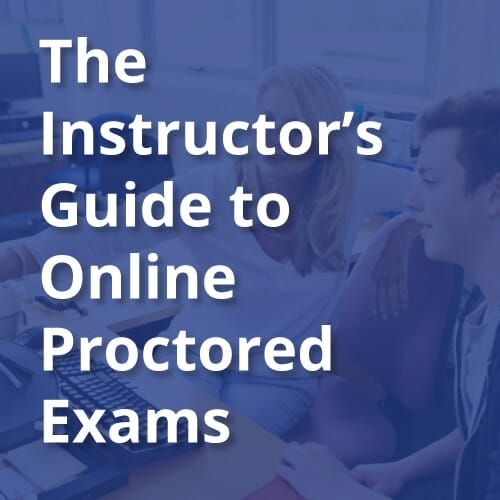If you’ve ever caught yourself feeling overwhelmed by the thought of adapting to new technology in education, you’re not alone — the field is evolving so quickly that it can be challenging to keep up. And, while it’s true that not every shiny new solution is necessary or helpful, it’s essential to evaluate each one and implement those that will improve the experiences of your students and faculty.
When considering a new piece of technology, you have several priorities to balance. One is efficiency — does this new tool make things run more smoothly, or does it create friction and frustration for everyone involved? At the same time, it’s vital to maintain a sense of humanity and connection — students want to know that they are more than a number and that their learning experience is specific to them. While these goals may seem to conflict with one another, in reality, they often go hand-in-hand.
A Shared Solution
By integrating automation and artificial intelligence into the classroom, you can begin to respond to concerns about both efficiency and personalized learning. This works in several ways. By increasing efficiency in education for teachers, you save them time, allowing them more bandwidth to connect with each student. They can identify struggles, provide guidance and tailor the learning experience. At the same time, implementing artificial intelligence can provide a more personalized learning experience as the software adapts to each student’s needs and helps them learn. And, by creating an efficient and easily navigable context for students, you also offer them more mental capacity to focus on learning. Instead of worrying about the minute details of class scheduling or how to take an exam, they can attend office hours and study sessions to gain further clarity on difficult material.
Automation and Artificial Intelligence
At Honorlock, we’ve seen first-hand just how valuable AI and automation can be in the classroom. We’re continually evaluating new educational technologies to find the most useful and streamlined solutions for efficiency in education. Wondering how these tools can help contribute to efficient teaching strategies in your context? Here are four of our favorite ways to harness the power of technology in education.
- Class Registration — When it comes to implementing automation, class registration can be a great place to start. Students love the convenience of registering online from anywhere and using a system that can easily cross-check issues like prerequisites eliminates potential mistakes and helps students stay on track with their degree plans. It’s easier than ever for students to track their academic progress and work with their advisors to create the perfect schedule from semester to semester. AI and automation in this process can also ensure that a student never double books their time. This can prevent headaches down the road from having to change class schedules at the last minute and helps students make sure they get into every course they need each semester so they can graduate in a timely manner.
- Room Scheduling & Facilities Management — Few things are more frustrating than reserving a room on campus, only to find that someone else has also reserved it and is already using it. This is a challenge for scheduling conference rooms and private study rooms, but it’s even more of a problem when it comes to classrooms — sometimes disrupting an entire class period (or more) as faculty sort out the issue. Thanks to AI and automation, however, this is becoming less and less of a problem on campuses. By using an intelligent scheduler, your school can prevent conflicts and ensure that the correct people are in the correct place at the correct time. And, by adding automation, you can make it even easier to schedule recurring events like meetings and classes. Ultimately, by making this process smoother and less frustrating, you can help your students and your faculty focus on the learning experience rather than the logistics required to make it happen.
- Grading — For faculty, one of the most challenging parts of the day can be facing the stack of papers left at the end of class. Whether assignments are physical or digital, the task of grading can seem impossible. TAs have long been part of solving this problem, and they continue to be vital in the grading process, but, especially in large classes, the amount of correction required can still be overwhelming. Thanks to new developments in AI and automation, however, it can be easier than ever to manage. Whether checking for plagiarism, correcting grammar or grading multiple-choice assessments, there are more tools than ever to help faculty spend less time focused on minute details and more time focused on concepts and student success.
- Online Exams — One of the simplest and most important places to integrate automation and artificial intelligence is in exams. Students are looking for a straightforward on-demand process, and faculty want to know that students are maintaining integrity in answering questions. With a solution like Honorlock’s Live Proctor Pop-In, your institution gets the best in online exams. Students don’t have to schedule in advance — their exams are ready and waiting for them 24/7/365. Throughout the test, students are monitored by artificial intelligence. If the system detects a potential violation, such as talking to someone else in the room or walking away from the computer, it alerts a live proctor. They then pop into the exam session to check in with the student. If the student is attempting to cheat, the proctor can intervene appropriately. If not, they can get the student back on track with the rest of their test. Both students and faculty can have confidence that tests will be proctored effectively, helping students focus on learning and faculty focus on teaching instead of worrying about the logistics of exams.
Using Technology to Maximize Efficiency in Education
When it comes to equipping students to learn well, efficiency is a crucial element. By implementing automation and AI, you free faculty and students from worrying about minute details. Ultimately, this leads to a greater focus on education and higher rates of student success.
To learn more about automation and AI in Honorlock’s online proctoring system, click here.
Sign up below to receive more resources for tips, best practices, white papers, and industry trends
Want to see Honorlock in action? Schedule a demo.



